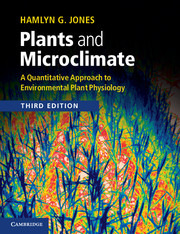Book contents
- Frontmatter
- Contents
- Preface
- Acknowledgements
- Symbols
- Main abbreviations and acronyms
- 1 A quantitative approach to plant–environment interactions
- 2 Radiation
- 3 Heat, mass and momentum transfer
- 4 Plant water relations
- 5 Energy balance and evaporation
- 6 Stomata
- 7 Photosynthesis and respiration
- 8 Light and plant development
- 9 Temperature
- 10 Drought and other abiotic stresses
- 11 Other environmental factors: wind, altitude, climate change and atmospheric pollutants
- 12 Physiology and crop yield improvement
- Appendices
- References
- Index
11 - Other environmental factors: wind, altitude, climate change and atmospheric pollutants
Published online by Cambridge University Press: 05 June 2014
- Frontmatter
- Contents
- Preface
- Acknowledgements
- Symbols
- Main abbreviations and acronyms
- 1 A quantitative approach to plant–environment interactions
- 2 Radiation
- 3 Heat, mass and momentum transfer
- 4 Plant water relations
- 5 Energy balance and evaporation
- 6 Stomata
- 7 Photosynthesis and respiration
- 8 Light and plant development
- 9 Temperature
- 10 Drought and other abiotic stresses
- 11 Other environmental factors: wind, altitude, climate change and atmospheric pollutants
- 12 Physiology and crop yield improvement
- Appendices
- References
- Index
Summary
This chapter considers a number of related aspects of the aerial environment that have not been adequately treated elsewhere in this book – these include wind and the effects of altitude, climate change and the ‘greenhouse effect’ and their implications for plant growth, and the effects of atmospheric pollutants. All these areas bring together principles that have been introduced earlier. Further details of these and other features of the microenvironment of plants are discussed by Geiger (1965), Grace et al. (1981), Campbell and Norman (1998), Garratt (1992), and Monteith and Unsworth (2008) while information on the scientific consensus on aspects of climate change may be found in the fourth consensus report of the Intergovernmental Panel on Climate Change (Core-Writing-Team et al., 2008; Solomon et al., 2007).
Wind
Not only is wind directly involved in heat and mass transfer by forced convection (see Chapter 3), but it is important to plants in many other ways including the dispersal of pollen and seeds and other propagules, and in shaping vegetation, either directly or, particularly at coastal sites, by means of transported sand or salt (Grace, 1977).
Measurement and variability
Wind is very variable both in direction and velocity. In general wind speeds tend to be greater during the day than at night (Figure 11.1), largely as a result of the convection processes set up by solar heating of the Earth's surface during the day.
- Type
- Chapter
- Information
- Plants and MicroclimateA Quantitative Approach to Environmental Plant Physiology, pp. 290 - 320Publisher: Cambridge University PressPrint publication year: 2013



